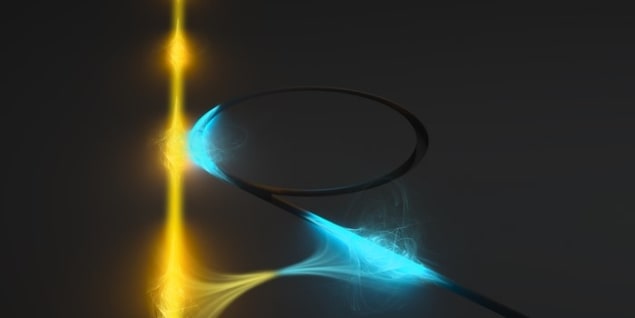
The quantum entanglement of a free electron with a photon has been achieved by researchers in Germany and Switzerland. The team, led by Armin Feist at the Max Planck Institute for Multidisciplinary Sciences, achieved the feat using a new experimental setup, which combines elements of photonics and electron microscopy.
Entanglement in quantum mechanics occurs when two or more particles are described by a single quantum state – giving the particles a much closer relationship than allowed by classical physics.
In the rapidly-growing field of quantum technology, the ability to establish entanglement between particles is often crucial. One particularly important application of entanglement is “heralding” whereby the detection of one particle in an entangled pair indicates that the other particle is available for use in a quantum circuit.
Hybrid pairs
Entangled particles do not need to be identical, and a new class of hybrid quantum technologies are emerging that rely on the entangled pairs of different particles – photons and electrons, for example. However, developing practical ways of entangling hybrid pairs remains a challenge.
Feist and colleagues have addressed this issue by creating a new experimental setup that features a ring-shaped optical microresonator that is placed on a photonic chip. Using an electron microscope, the researchers also created a beam of high-energy electrons, which passes tangentially to the ring. As they pass the ring, the electrons interact with the evanescent field of the microresonator. This results in the creation of photons within the ring. Crucially, each of these new photons is entangled with an electron in the beam. These photons are then extracted from the ring using an optical fibre.
To test their setup, Feist’s team collected the electrons and their corresponding photons in separate detectors, then measured the coincidence between their quantum states. As they hoped, the detector confirmed that the electron-photon pairs had become entangled during the interaction process.

Distillation method strengthens quantum entanglement in a single pair of photons
The team hopes that their technique could inspire innovations in electron microscopy. Through heralding, it could allow researchers to probe the interaction between electron beams and atomic-scale samples by studying the effects of the interaction on the entangled photons. These photons would be far easier to measure directly than the electrons – and this could enhance the sensitivity and imaging capabilities of electron microscopy.
More broadly, their approach could extend the toolkit of quantum information science to include free electrons – potentially opening new possibilities for innovations in quantum computing and communications.
The research is described in Science.
